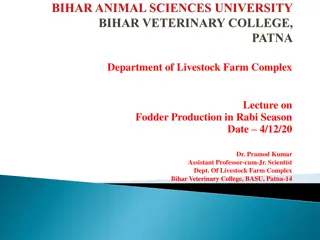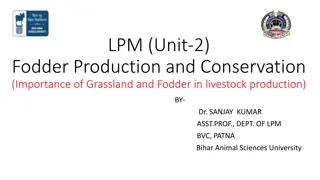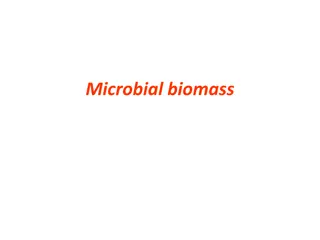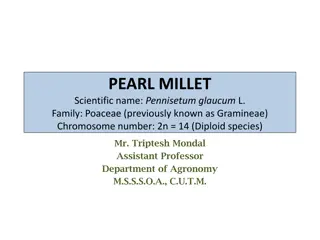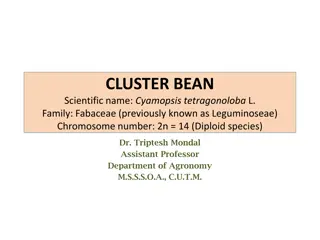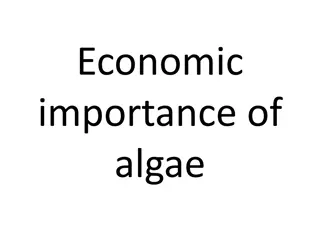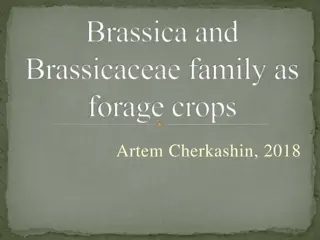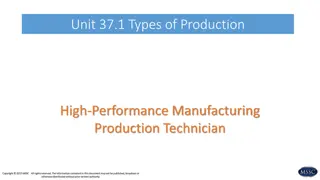Agronomical Practices for Fodder Production - Part 2
General cultivation concepts for fodder production include primary and secondary tillage practices. Primary tillage consists of deep ploughing, subsoiling, and year-round tillage. Deep tillage is essential for deep-rooted crops while subsoiling breaks hard pans in the soil. Year-round tillage involves operations carried out throughout the year. Secondary tillage includes finer operations after primary tillage to prepare the soil for sowing.
Download Presentation

Please find below an Image/Link to download the presentation.
The content on the website is provided AS IS for your information and personal use only. It may not be sold, licensed, or shared on other websites without obtaining consent from the author. Download presentation by click this link. If you encounter any issues during the download, it is possible that the publisher has removed the file from their server.
E N D
Presentation Transcript
Agronomical Practices for fodder production (Part -2) By- Sanjay Kumar Asst. Prof., Dept. of LPM, BVC, Bihar Animal Sciences University, Patna
General cultivation concept for fodder production 1. Tillage- Tillage is defined as the mechanical manipulation of the soil for the purpose of crop production. It is the turning the soil to control for weeds and pests and to prepare for seeding. The fundamental purposes of tillage are- (i) to prepare a suitable seedbed, (ii) to eliminate competition from weed growth, and (iii) to improve the physical condition of the soil. Annual fodder crops require minimum tillage of 2 or 3 ploughings.
Types of tillage Tillage is of 2 types- 1. Primary tillage It is further of 3 types- a. Deep tillage b. Sub-soiling c. Year round tillage 2. Secondary tillage
Types of Primary Tillage They are deep ploughing, subsoiling and year-round tillage. Deep Tillage Deep ploughing turns out large sized clods, which are baked by the hot sun when it is done in summer. These clods crumble due to alternate heating and cooling and due to occasional summer showers. . A deep tillage of 25-30 cm depth is necessary for deep rooted crop like pigeon pea while moderate deep tillage of 15-20 cm is required for maize. Deep tillage also improves soil moisture content. However the advantage of deep tillage in dry farming condition depends on rainfall pattern and crop. It is advisable to go for deep ploughing only for long duration, deep rooted crops.
Subsoiling Hard pans may be present in the soil which restrict root growth of crops. These may be silt pans, iron or aluminium pans, clay pans or - man-made pans. Man-made pans are tillage pans induced by repeated tillage at the same depth. Subsoiling is breaking the hard pan without inversion and with less disturbance of top soil. A narrow cut is made in the top soil while share of the subsoiler shatters hard pans. Chisel ploughs are also used to break hard pans present even at 60-70 cm. The effect of subsoiling does not last long.
Year-round Tillage Tillage operations carried out throughout the year are known as year-round tillage. Repeated tillage operations are carried out until sowing of the crop. Even after harvest of the crop, the field is repeatedly ploughed or harrowed to avoid weed growth in the off season.
Secondary Tillage Lighter or finer operations performed on the soil after primary tillage are known as secondary tillage. After ploughing, the fields are left with large clods with some weeds and stubbles partially uprooted. Harrowing is done to a shallow depth to crush the clods and to uproot the remaining weeds and stubbles. Disc harrows, cultivators, blade harrows etc., are used for this purpose.
Manures and fertilizers Generally forage crops takes nutrient from residual effect of manuring done to the previous crop. So, extra manure is not required , but sometime for good yield additional manure application may be applied. Manures are obtained whereas fertilizers are synthetically the factories. Manures are organic in whereas fertilizers are inorganic in nature and may harm the useful microbes present in the soil and also decrease the soil fertility if used for a longer time. from natural manufactured sources, in nature and eco-friendly,
Seed Rate Seed rate is the quantity of seed of a crop that is required to sow a unit area of land for optimum crop production. Heavy seed rate is adopted for annual fodder. It will give thick stand of crop with good yield.
Importance of determining seed rate To maintain optimum plant population in the field for higher yield harvest. To prevent seed wastage from excess sowing such reduces the initial cost of production. To know the quantity of seed needed for sowing in advance.
Seed inoculation- Seed inoculation is the practice of covering the seed surface with a nitrogen-fixing bacteria (Rhizobium or Brady rhizobium) prior to planting. The bacteria penetrates the root, resulting in the formation of root nodules that fix nitrogen from the air and make it readily available to the plant. It protects the nitrogen fixing bacteria, needed, due to the fact that most seeds carry natural toxins against soil decay which destroy Rhizobia as well. Typically, inoculation is performed via mechanical wounding or grafting. Mechanical inoculation includes cutting, slashing, and rubbing
Stage of harvesting- Different crops have different harvesting stage. The milk stage is when the grain head releases a white liquid substance when opened. The dough stage is when the grain head begins to turn to a doughy consistency. As the plant boot stage to the dough stage, forage quality decreases while yield increases. In annual grain crops, harvesting should be done at milk stage, while in leguminous crop, harvesting should be done at pod formation stage. matures from the
Fodder Conservation Fodder Conservation methods- Excess or surplus fodder are conserved by hay or silage making methods depending upon the weather conditions. Ensiling is a process which involves the conservation of green fodder crops, grasses and the storage over long period. Feeding strategies based on conserved fodder include feeding of dry fodder (hay, dried crop residues or grazing of dried grasses), silage (preserved green fodder or grasses) and standing hay/stover (standing mature fodder crop or crop residue
Crop rotation Crop different crops sequentially on the same plot of land to improve soil health, optimize nutrients in the soil, and combat pest and weed pressure. Some crops are cultivated as catch crops before or after main crop production or in between two important crops. It will improve the palatability or nutritive value of forage material. eg- production of legume crop after rice crop. The sequence of four crops (wheat, turnips, barley and clover), included a fodder crop and a grazing crop, allowing livestock to be bred year-round. rotation is the practice of planting
Rice-fallow crops In the rice-fallow system, rainfed rice is grown in the wet season (kharif) and the land lies fallow during the subsequent dry winter (Rabi) and summer periods, except for weeds that are grazed. Rice-fallow cropland areas are those areas where rice is grown during the kharif growing season (June October), followed by a fallow during the rabi season (November February). In eastern India, vast areas are lying fallow after the rice (Oryza sativa L.) crop is harvested. Rice-fallow areas can be better utilized in establishing pulse crop utilizing the residual soil moisture through conservation agricultural practices, of rice crop by utilizing the residual soil moisture. after the harvest
Moisture availability- For good yield of fodder, the soil moisture range from field capacity to about 75% of availability Thanks









